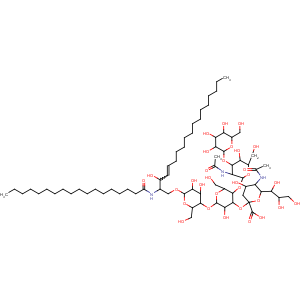Title: Gangliosides
Literature References: Animal glycosphingolipids occurring in highest concentration in the central nervous system but widely distributed in other tissues. Primarily located in the outer surface of mammalian cell plasma membranes, they are also found in the synaptic membrane of the central nervous system. More than 60 gangliosides have been characterized. Each consists of a fatty acid (often stearic acid) and an oligosaccharide moiety, both attached to sphingosine. Sialic acid,
q.v., is the identifying sugar. The sialic acid residues of gangliosides and those of glycoprotein are the main cause of cell surface negative charge. Gangliosides are also thought to be involved in many different cell functions, e.g. metabolism, growth, malignant transformation. Ganglioside nomenclature: L. Svennerholm, "Ganglioside Metabolism" in
Comprehensive Biochemistry vol. 18, M. Florkin, E. H. Stotz, Eds. (Elsevier, Amsterdam, 1970) pp 201-204. Isoln from normal brain and from the brain of patients with Tay-Sachs disease: Klenk,
Z. Physiol. Chem. 268, 50 (1941);
273, 76 (1942); Trams, Lauter,
Biochim. Biophys. Acta 60, 350 (1962); Svennerholm,
Acta Chem. Scand. 17, 239 (1963). Occurrence of different gangliosides: Kuhn, Egge,
Angew. Chem. 72, 805 (1960). Chromatographic studies: Kuhn
et al., ibid. 73, 580 (1961); Klenk, Gielen,
Z. Physiol. Chem. 326, 144 (1961). Structure of ganglioside GI (or GM1): Kuhn, Wiegandt,
Ber. 96, 866 (1963). Structure of gangliosides GI and GII (or GD1a): Kuhn, Egge,
ibid. 96, 3338 (1963). Structure of gangliosides GII, GIII (or GD1b) and GIV (or GT1b): Kuhn, Wiegandt,
Z. Naturforsch. 18b, 541 (1963). Molecular diversity, biological implications of brain and thymus gangliosides: Y. Nogai, M. Iwamori,
Mol. Cell. Biochem. 29, 81 (1980). Biosynthesis in tissues: S. Basu
et al., Adv. Exp. Med. Biol. 125, 213 (1980). Action as biotransducers of membrane-mediated information: R. O. Brady, P. H. Fishman,
Adv. Enzymol. 50, 303 (1979). Reviews: Wiegandt,
Angew. Chem. Int. Ed. 7, 87-96 (1968). Collection of articles on structure and function:
Adv. Exp. Med. Biol. 125, 1-555 (1980); on structure analysis, function and properties, regeneration and recovery in the nervous system, clinical trials in amyotropic lateral sclerosis and diabetic neuropathy:
ibid. 174, 1-649 (1984). Book:
Gangliosides in Neurological and Neuromuscular Function, Development, and Repair M. M. Rapport, A. Gorio, Eds. (Raven Press, New York, 1981) 267 pp.
Properties: Gangliosides are colorless crystallizable substances which melt with decompn. Insol in non-polar solvents. Soly in polar solvents increases with the size of the sugar residue and the sialic acid content. Forms micelles in aq soln, having mol wt of about 200,000-250,000. Forms molecular solns in DMF or tetrahydrofuran, having mol wt of 1000-3000.
Derivative Type: Ganglioside GM1
CAS Registry Number: 37758-47-7
Synonyms: Siagoside
Trademarks: Sygen (Fidia)
Molecular Formula: C73H131N3O31
Molecular Weight: 1546.82
Percent Composition: C 56.68%, H 8.54%, N 2.72%, O 32.06%
Derivative Type: Combination of gangliosides GM1, GD1a, GD1b, and GT1b
Trademarks: Cronassial (Fidia); Gangliovet (Fidia)
Therap-Cat: In treatment of peripheral neuropathies.
Therap-Cat-Vet: In treatment of peripheral neuropathies.

